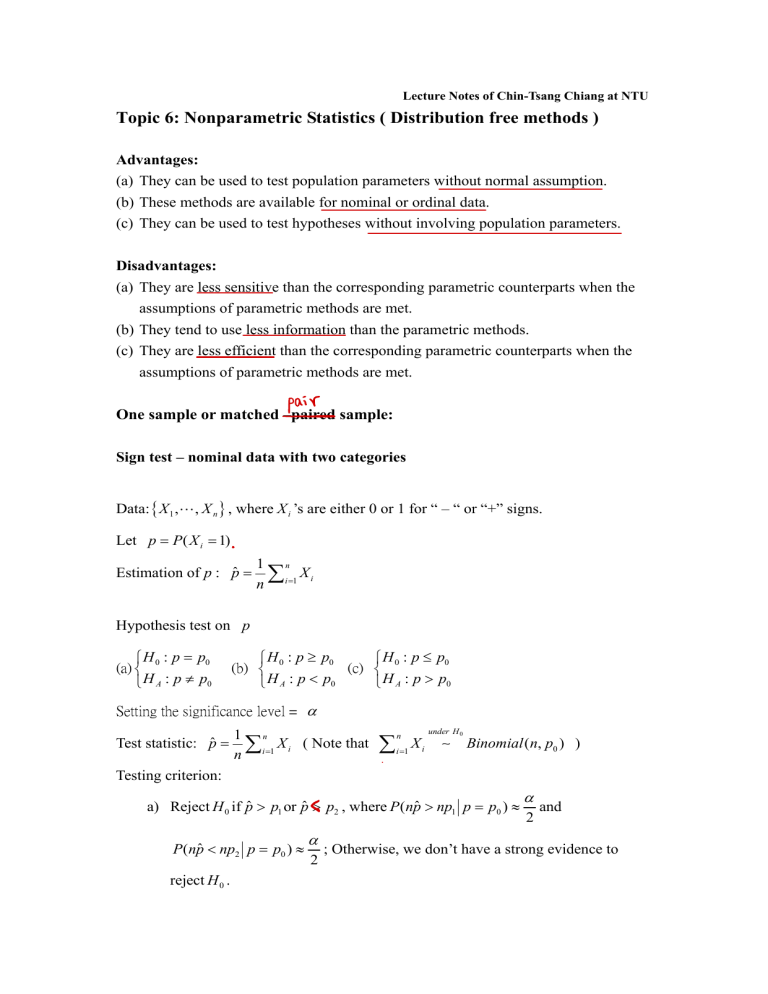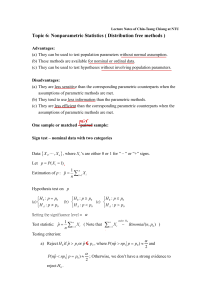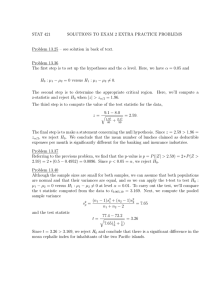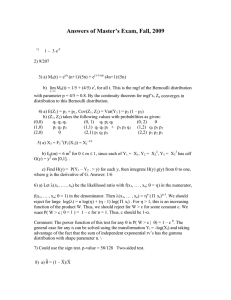
Lecture Notes of Chin-Tsang Chiang at NTU
Topic 6: Nonparametric Statistics ( Distribution free methods )
Advantages:
(a) They can be used to test population parameters without normal assumption.
(b) These methods are available for nominal or ordinal data.
(c) They can be used to test hypotheses without involving population parameters.
Disadvantages:
(a) They are less sensitive than the corresponding parametric counterparts when the
assumptions of parametric methods are met.
(b) They tend to use less information than the parametric methods.
(c) They are less efficient than the corresponding parametric counterparts when the
assumptions of parametric methods are met.
N.
One sample or matched –paired sample:
Sign test – nominal data with two categories
Data: X 1 ,
Let p
, X n , where X i ’s are either 0 or 1 for “ – “ or “+” signs.
P( X i
1)
Estimation of p : pˆ
1
n
n
i 1
Hypothesis test on p
Xi
H0 : p
p0
H0 : p
p0
H0 : p
p0
HA : p
p0
HA : p
p0
HA : p
p0
1
n
Test statistic: pˆ
Testing criterion:
a) Reject H 0 if p̂
P (npˆ
np2 p
reject H 0 .
n
i
X i ( Note that
1
i
Xi
1
p2 , where P (npˆ
p1 or p̂
p0 )
n
2
under H 0
Binomial (n, p0 ) )
np1 p
p0 )
2
and
; Otherwise, we don’t have a strong evidence to
b) Reject H 0 if p̂
p2 , where P (npˆ
np2 p
p0 )
; Otherwise, we don’t have
np1 p
p0 )
; Otherwise, we don’t have
a strong evidence to reject H 0 .
c) Reject H 0 if p̂
p1 , where P (npˆ
a strong evidence to reject H 0 .
p0 and Var[ pˆ ]
Under H 0 , E[ pˆ ]
is
p0 (1 p0 )
n
n pˆ
When the sample size n is large enough, Z 0
↓
p0
approxmated by
d
X N (0,1) . Thus, the
p0 1 p0
testing criterion can be based on Z 0 statistic.
Application: Conduct a test about the population median, i.e.
A.
H0 : M
M0
H0 : M
M0
HA : M
M0
HA : M
M0
X
H 0 : f X ( x) is symmetric about
n
≤
M0
HA : M
M0
M
0
)
&
%
=
出
f X ( x)
0
H A : f X ( x) is asymmetric about
T
D = I (X
H0 : M
0
r , where ri
(i.e. symmetric about another value)
sign( X i
i 1 i
0
)rank ( X i
0
)
populations
rpair
measurements
照
For a matched-paired
sample, let X 1 and X 2 denote the measurement of population 1
and 2, respectively. Assume that D X 1 X 2 has a symmetric p.d.f. f D ( d )
H 0 : f D (d ) is symmetric about
0
H A : f D (d ) is symmetric about another value
Üi
n
T
n
Under H 0 , T
i 1
n
Var T
i
n
Thus, E[T ]
i 1
r , where ri
i 1 i
r
1 i
d
n
i 1
sign( X i
E[ sign( X i
Var ( sign( X i
些
X )rank ( X
sign( X i1
0
0
i 1
(1
1
1
( 1) ) i
2
2
0 , and
1 i2
i 1
T
n(n 1)(2n 1)
6
When n is large enough,
X i2 )
n(n 1)(2n 1)
.
6
canbe approxmated
by
d
Λ N (0,1) .
n
)) i 2
i1
) i
0
n
)] i
i2
Two independent samples:
Mann-Whitney-Wilcoxon test – At least ordinal scale variable
ipative.ly
Let X 1 and X 2 denote separately the measurement of populations 1 and 2, with the
i
n
corresponding distributions FX1 ( x)
FX 2 ( x)
Population 1
Population 2
X 11
X 12
Random samples
X 1n1
Let T1
n1
i 1
Independent
X 21
X 22
X 2n2
rank ( X 1i ) , where rank ( X 1i ) is the rank of X 1i among
{ X ij : i 1, 2 ; j 1,
, ni } .
,
.
Hypothesis:
H 0 : FX1 ( x)
FX 2 ( x)
H A : FX1 ( x)
FX 2 ( x) for at least one x
Test statistic: T1
Testing criterion: Reject H 0 if T1 T2 or T1 TU , where TL TU
Otherwise, we don’t have a strong evidence to reject H 0 .
n1 (n1 n2 1) .
Remark: Under H 0 , one has
E[T1 ]
1
1
n1 (n1 n2 1) and Var (T1 )
n1n2 (n1 n2 1) .
2
12
T1
When n1 and n2 are large enough,
k-independent samples ( k
1
n1 (n1 n2 1)
2
d
1
n1n2 (n1 n2 1)
12
N (0,1)
2 ):
Kruskall-Wallis test – At least ordinal scale variable
Let X 1 ,
, X n denote separately the measurements of populations 1,
corresponding distributions FX1 ( x)
FX k ( x)
Population 1
Population 2
Population k
X 21
X k1
X 11
Random samples
X 12
Independent
X 1n1
X 22
X 2n2
Hypothesis:
H 0 : FX1 ( x)
FX 2 ( x)
H A : FX i ( x)
FX j ( x) for some i
,k with the
FX k ( x)
j and some x
Independent
Xk2
X knk
R ( X ij )
X ij
k
nT
, k ; j 1,
, ni } and Ri
ni
j 1
R( X ij )
n
i 1 i
k
i
n
1 i
12
nT (nT 1)
SSB
MST
Test statistic: W
SSB
{ X ij : i 1,
ni
j
(
1
When nT is large, W
Ri
ni
d
k
i
Ri2
1
ni
nT 1 2
) and MST
2
2
k 1
.
3(nT 1) , where
1
nT 1
(
k
ni
i 1
j
R 2 ( X ij ) nT
1
(nT 1) 2
).
4






